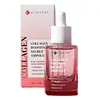What's inside
What's inside
 Key Ingredients
Key Ingredients

 Benefits
Benefits

 Concerns
Concerns

 Ingredients Side-by-side
Ingredients Side-by-side

Helianthus Annuus Seed Oil
EmollientVegetable Oil
Skin ConditioningAscorbic Acid 15%
AntioxidantPolyglyceryl-2 Triisostearate
EmulsifyingDiisostearyl Malate
EmollientCetyl Ethylhexanoate
EmollientCeresin
Emulsion StabilisingDipentaerythrityl Hexahydroxystearate/Hexastearate/Hexarosinate
Skin ConditioningHexyldecyl Ethylhexanoate
EmollientBeeswax
Emulsion StabilisingEuphorbia Cerifera Wax
Dipropylene Glycol
HumectantShorea Robusta Seed Butter
EmollientSucrose Tetrastearate Triacetate
EmollientParfum
MaskingCaprylyl Glycol
EmollientCopernicia Cerifera Wax
Hippophae Rhamnoides Oil
EmollientEthylhexylglycerin
Skin ConditioningGlycyrrhiza Uralensis Extract
EmollientTocopheryl Acetate
AntioxidantAdenosine
Skin ConditioningWater
Skin ConditioningButylene Glycol
HumectantHydrolyzed Collagen 0%
EmollientPanthenol
Skin Conditioning1,2-Hexanediol
Skin ConditioningAcetyl Hexapeptide-8
HumectantCopper Tripeptide-1
Skin ConditioningPalmitoyl Pentapeptide-4
Skin ConditioningOligopeptide-1
Skin ConditioningOligopeptide-2
Skin ConditioningHelianthus Annuus Seed Oil, Vegetable Oil, Ascorbic Acid 15%, Polyglyceryl-2 Triisostearate, Diisostearyl Malate, Cetyl Ethylhexanoate, Ceresin, Dipentaerythrityl Hexahydroxystearate/Hexastearate/Hexarosinate, Hexyldecyl Ethylhexanoate, Beeswax, Euphorbia Cerifera Wax, Dipropylene Glycol, Shorea Robusta Seed Butter, Sucrose Tetrastearate Triacetate, Parfum, Caprylyl Glycol, Copernicia Cerifera Wax, Hippophae Rhamnoides Oil, Ethylhexylglycerin, Glycyrrhiza Uralensis Extract, Tocopheryl Acetate, Adenosine, Water, Butylene Glycol, Hydrolyzed Collagen 0%, Panthenol, 1,2-Hexanediol, Acetyl Hexapeptide-8, Copper Tripeptide-1, Palmitoyl Pentapeptide-4, Oligopeptide-1, Oligopeptide-2
Water
Skin ConditioningCollagen Extract
Skin ConditioningMethylpropanediol
SolventBifida Ferment Filtrate
Skin ConditioningGlycerin
Humectant1,2-Hexanediol
Skin ConditioningAlcohol
AntimicrobialButylene Glycol
HumectantCarbomer
Emulsion StabilisingPPG-13-Decyltetradeceth-24
EmulsifyingTromethamine
BufferingHyaluronic Acid
HumectantAdenosine
Skin ConditioningParfum
MaskingDisodium EDTA
Panthenol
Skin ConditioningLactobacillus Ferment
Skin ConditioningEthylhexylglycerin
Skin ConditioningCollagen
MoisturisingHydrogenated Lecithin
EmulsifyingHydroxydecyl Ubiquinone
AntioxidantLactococcus Ferment Extract
Skin ConditioningBifida Ferment Extract
HumectantLactobacillus Ferment Lysate
Skin ConditioningArgania Spinosa Kernel Oil
EmollientYeast Extract
Skin ConditioningTocopherol
AntioxidantWater, Collagen Extract, Methylpropanediol, Bifida Ferment Filtrate, Glycerin, 1,2-Hexanediol, Alcohol, Butylene Glycol, Carbomer, PPG-13-Decyltetradeceth-24, Tromethamine, Hyaluronic Acid, Adenosine, Parfum, Disodium EDTA, Panthenol, Lactobacillus Ferment, Ethylhexylglycerin, Collagen, Hydrogenated Lecithin, Hydroxydecyl Ubiquinone, Lactococcus Ferment Extract, Bifida Ferment Extract, Lactobacillus Ferment Lysate, Argania Spinosa Kernel Oil, Yeast Extract, Tocopherol
Ingredients Explained
These ingredients are found in both products.
Ingredients higher up in an ingredient list are typically present in a larger amount.
1,2-Hexanediol is a synthetic liquid and another multi-functional powerhouse.
It is a:
- Humectant, drawing moisture into the skin
- Emollient, helping to soften skin
- Solvent, dispersing and stabilizing formulas
- Preservative booster, enhancing the antimicrobial activity of other preservatives
Adenosine is in every living organism. It is one of four components in nucleic acids that helps store our DNA.
Adenosine has many benefits when used. These benefits include hydrating the skin, smoothing skin, and reducing wrinkles. Once applied, adenosine increases collagen production. It also helps with improving firmness and tissue repair.
Studies have found adenosine may also help with wound healing.
In skincare products, Adenosine is usually derived from yeast.
Learn more about AdenosineButylene Glycol (or BG) is used within cosmetic products for a few different reasons:
Overall, Butylene Glycol is a safe and well-rounded ingredient that works well with other ingredients.
Though this ingredient works well with most skin types, some people with sensitive skin may experience a reaction such as allergic rashes, closed comedones, or itchiness.
Learn more about Butylene GlycolEthylhexylglycerin (we can't pronounce this either) is commonly used as a preservative and skin softener. It is derived from glyceryl.
You might see Ethylhexylglycerin often paired with other preservatives such as phenoxyethanol. Ethylhexylglycerin has been found to increase the effectiveness of these other preservatives.
Panthenol is a common ingredient that helps hydrate and soothe the skin. It is found naturally in our skin and hair.
There are two forms of panthenol: D and L.
D-panthenol is also known as dexpanthenol. Most cosmetics use dexpanthenol or a mixture of D and L-panthenol.
Panthenol is famous due to its ability to go deeper into the skin's layers. Using this ingredient has numerous pros (and no cons):
Like hyaluronic acid, panthenol is a humectant. Humectants are able to bind and hold large amounts of water to keep skin hydrated.
This ingredient works well for wound healing. It works by increasing tissue in the wound and helps close open wounds.
Once oxidized, panthenol converts to pantothenic acid. Panthothenic acid is found in all living cells.
This ingredient is also referred to as pro-vitamin B5.
Learn more about PanthenolParfum is a catch-all term for an ingredient or more that is used to give a scent to products.
Also called "fragrance", this ingredient can be a blend of hundreds of chemicals or plant oils. This means every product with "fragrance" or "parfum" in the ingredients list is a different mixture.
For instance, Habanolide is a proprietary trade name for a specific aroma chemical. When used as a fragrance ingredient in cosmetics, most aroma chemicals fall under the broad labeling category of “FRAGRANCE” or “PARFUM” according to EU and US regulations.
The term 'parfum' or 'fragrance' is not regulated in many countries. In many cases, it is up to the brand to define this term.
For instance, many brands choose to label themselves as "fragrance-free" because they are not using synthetic fragrances. However, their products may still contain ingredients such as essential oils that are considered a fragrance by INCI standards.
One example is Calendula flower extract. Calendula is an essential oil that still imparts a scent or 'fragrance'.
Depending on the blend, the ingredients in the mixture can cause allergies and sensitivities on the skin. Some ingredients that are known EU allergens include linalool and citronellol.
Parfum can also be used to mask or cover an unpleasant scent.
The bottom line is: not all fragrances/parfum/ingredients are created equally. If you are worried about fragrances, we recommend taking a closer look at an ingredient. And of course, we always recommend speaking with a professional.
Learn more about ParfumWater. It's the most common cosmetic ingredient of all. You'll usually see it at the top of ingredient lists, meaning that it makes up the largest part of the product.
So why is it so popular? Water most often acts as a solvent - this means that it helps dissolve other ingredients into the formulation.
You'll also recognize water as that liquid we all need to stay alive. If you see this, drink a glass of water. Stay hydrated!
Learn more about Water